ChatGPT rules the AI world in 2025. These 40+ stats show just how many use it, why businesses rely on it, and what makes it the #1 chatbot today.
ChatGPT is the most widely used AI tool in 2025, with over 400 million monthly users, high enterprise adoption, and strong global engagement.
Here’s the exponential search demand growth in the last 3 years, according to Google Trends:
This listicle roundup lists 40+ important ChatGPT statistics covering user growth, usage behavior, workplace adoption, mobile installs, revenue, and market share. We gathered all data from trusted sources like Statista, Semrush, Bloomberg, OpenAI, and others to ensure accuracy.
Use this data to understand how ChatGPT is being used worldwide, how it’s impacting businesses, and where it stands in the AI ecosystem.
Hire AI-ready developers in 48 hours. Tap into Index.dev’s elite 5% talent pool with a 30-day risk-free trial.
Key ChatGPT highlights
- Most Popular AI Tool: 400.61M monthly users make ChatGPT the #1 AI app globally.
- Massive U.S. & India Usage: 745.87M users in the U.S. and 401.38M in India.
- High Engagement: Average session length is 14 min 36 sec; 4.4 pages per visit.
- Strong Loyalty: 89% of paying users stay subscribed for at least 1 quarter.
- Enterprise Powerhouse: Over 1.5M business users; used by 80% of Fortune 500 firms.
- Top Traffic Source: 79.77% of traffic is direct, showing strong brand recall.
- Developer Favorite: 79% of developers use ChatGPT for work.
- Explosive Mobile Growth: 500M+ downloads on Google Play with a 4.5-star rating.
- Revenue Surge Forecast: $3.7B in 2024, expected to reach $29.4B by 2026.
- Global Recognition: ChatGPT dominates usage in countries like Japan, the UK, and the USA.
- Market Share Giant: Owns 62.5% of the paid AI tool market and 79.76% of the chatbot share.
- High Daily Interaction: Over 1 billion messages are sent on ChatGPT each day.
ChatGPT user demographics
How widely is ChatGPT used around the world?
As of February 2025, ChatGPT had over 400.61 million monthly active users (MAU), making it the most popular AI application globally.
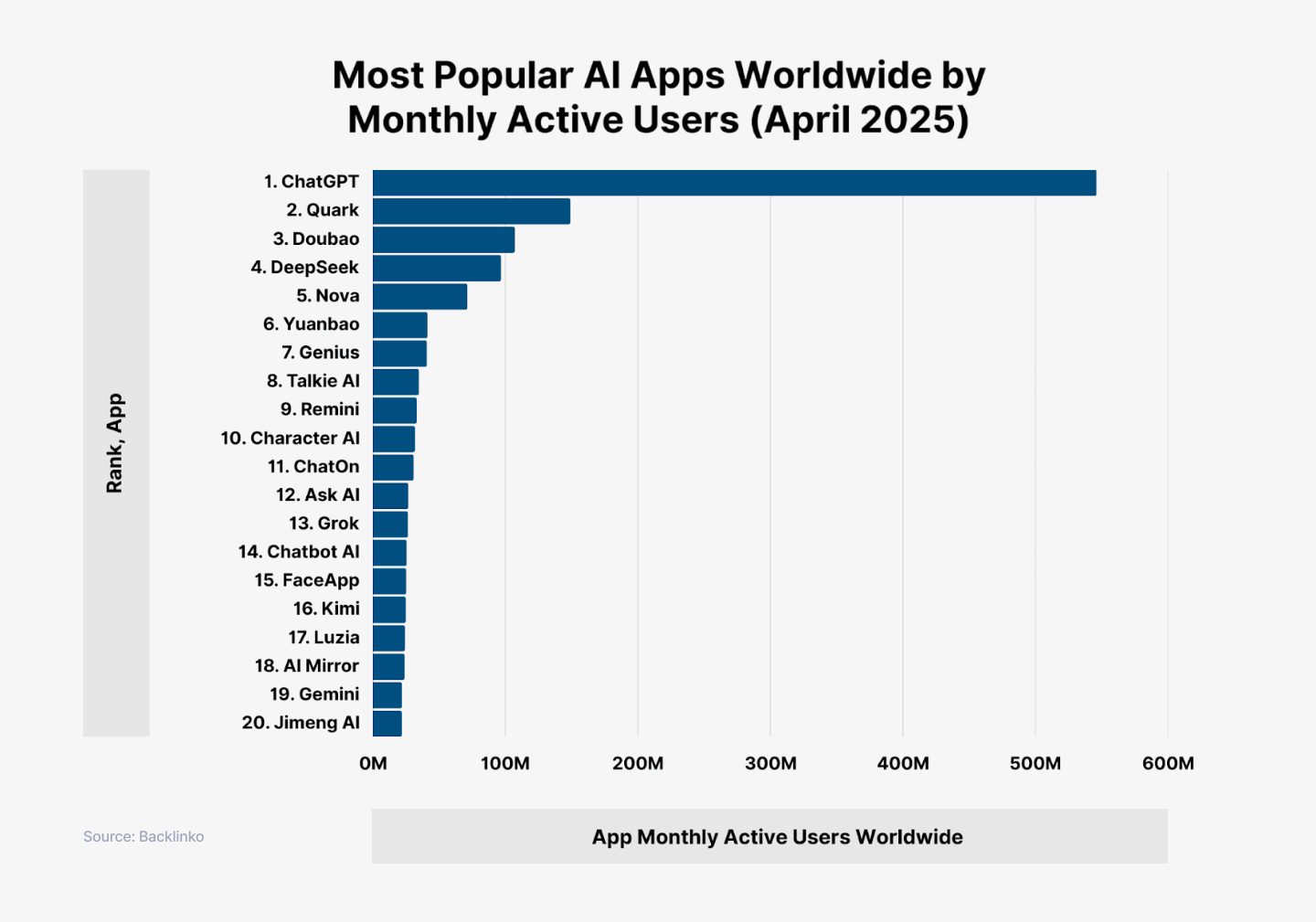
Source: Backlinko
This clearly places ChatGPT at the forefront of AI tools worldwide, ahead of all competitors. Its reach and influence are not limited to the U.S. or tech-savvy users; it’s a mainstream tool impacting work, study, and life globally.
Which country has the most ChatGPT users?
According to Semrush data insights, the U.S. leads with 745.87 million ChatGPT users, followed by India with 401.38 million users and Brazil with 243.64 million users.
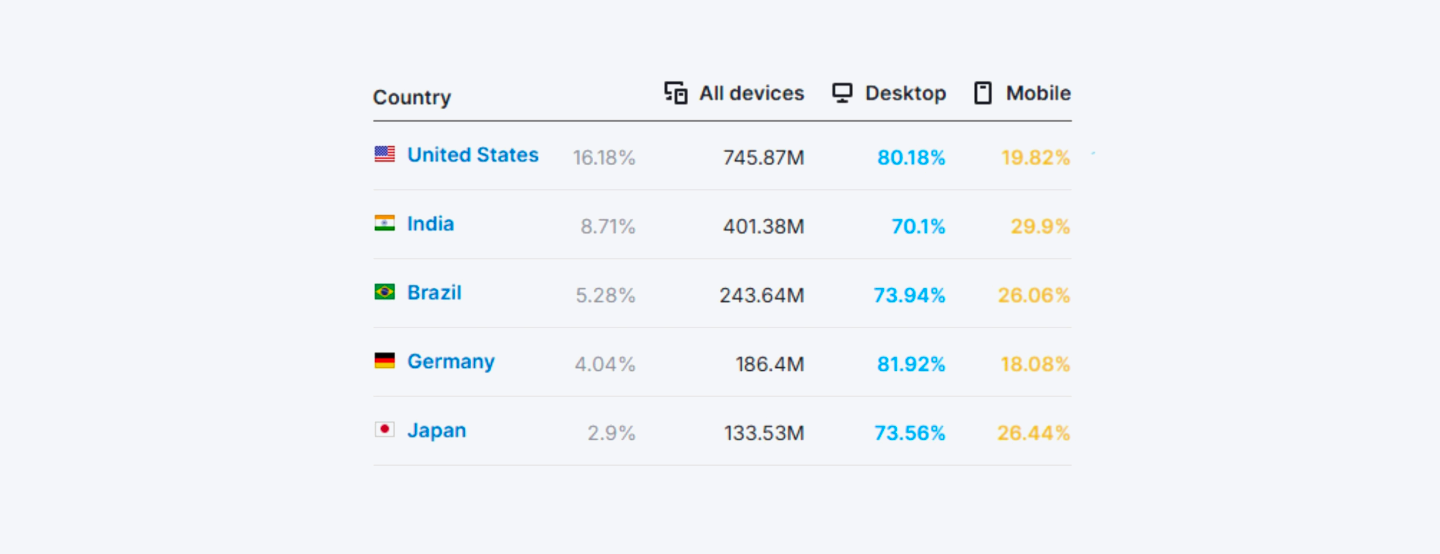
The U.S. and India are ChatGPT’s largest user sardararticle bases, demonstrating strong adoption in both developed and emerging markets. These figures reflect significant market penetration and widespread utility across industries and demographics.
How many users does ChatGPT have each week?
ChatGPT currently has 250 million weekly active users. The company is converting free users to paid products at a rate of 5-6%.
A weekly base of 250 million users points to consistent and repeated usage, not just trial or curiosity. It suggests deep integration into user routines, especially for tasks like coding, writing, and research.
Compare DeepSeek and ChatGPT's performance, cost, and user experience to see which will dominate in 2025.
ChatGPT usage patterns
How long do people typically use ChatGPT in a session?
The average ChatGPT session lasts 14 minutes and 36 seconds according to Semrush data insights, which is more than several news and shopping sites like Amazon, Times of India, BBC, etc.
Users are not just popping in and out. They are engaging meaningfully with the platform, often using it to complete complex tasks like writing code, generating content, or analyzing data.
How often do users return to ChatGPT?
89% of paying users buy the ChatGPT paid version after one quarter; 74% stay with ChatGPT after three quarters, as per Earnest credit card data.
This level of user retention shows strong customer satisfaction. Once people subscribe to ChatGPT, they typically continue finding enough value to maintain their subscription long term.
ChatGPT enterprise and B2B adoption
How many enterprise clients use ChatGPT?
ChatGPT has 1.5 million enterprise customers across its Enterprise, Team, and Edu offerings.
With over a million business customers, ChatGPT is not just a consumer tool. It’s now a workplace essential, powering productivity in industries from education to finance to software.
How fast did Fortune 500 companies adopt ChatGPT?
Over 80% of Fortune 500 companies adopted ChatGPT within 9 months of its launch.
Enterprise AI adoption typically takes years. ChatGPT's ability to capture this much of the Fortune 500 audience in months signals extraordinary enterprise trust and rapid ROI.
What security features are included in ChatGPT Enterprise?
ChatGPT Enterprise includes SOC 2 compliance, TLS 1.2+ encryption in transit, and AES-256 encryption at rest.
OpenAI emphasizes privacy and enterprise-grade security. These protocols assure companies that their data remains protected and compliant with global security standards.
ChatGPT Website and Traffic Insights
How popular is ChatGPT's website?
As of July 2025, ChatGPT ranks as the 5th most visited website in the world.

Being just behind Google, YouTube, and Facebook in web traffic places ChatGPT among the internet’s heavyweights. It confirms massive and recurring user interest.
Where does most ChatGPT traffic come from?
79.77% of traffic to ChatGPT comes from direct visits, 5.79% from referrals from Openai.com, and 5.10% from organic Google search.
Users bookmark or directly type the URL to use the ChatGPT platform, which is a strong sign of brand recall and habitual usage. It also reflects high user loyalty and dependency.
What devices do ChatGPT users prefer?
Desktops drive 76.22% of visits on ChatGPT, while 23.78% come from mobile devices.
Most users still prefer using ChatGPT on desktops, likely due to its productivity-centric nature. This suggests that people often turn to ChatGPT for serious tasks like work, writing, or development.
ChatGPT user behavior
How many pages do users typically view?
ChatGPT users view an average of 4.4 pages per visit.
This is almost 3x more than openai.com, indicating users stay engaged, interact with content deeply, and explore multiple features or threads per visit.
What is the bounce rate of ChatGPT?
ChatGPT has a bounce rate of 39.54%, lower than the 47.89% average of top websites.
Users don’t just visit and leave. A lower bounce rate means users are finding value and staying longer, likely completing tasks in the same session.
How many devices has ChatGPT been downloaded on?
ChatGPT has over 500 million downloads on Google Play, with a 4.5-star rating.
This immense download count shows ideasforeurope ChatGPT’s mainstream reach, making it one of the most installed apps globally. It also suggests a strong presence in Android-first markets like India.
ChatGPT usage by profession
Which profession uses ChatGPT the most?
Software developers top the chart with 79% ChatGPT adoption.
Developers have integrated ChatGPT into their workflows for coding, testing, and debugging. This high usage signals strong trust in its capabilities.
What about financial advisors?
Only 12% of financial advisors use ChatGPT at work; the total adoption rate is 34%.
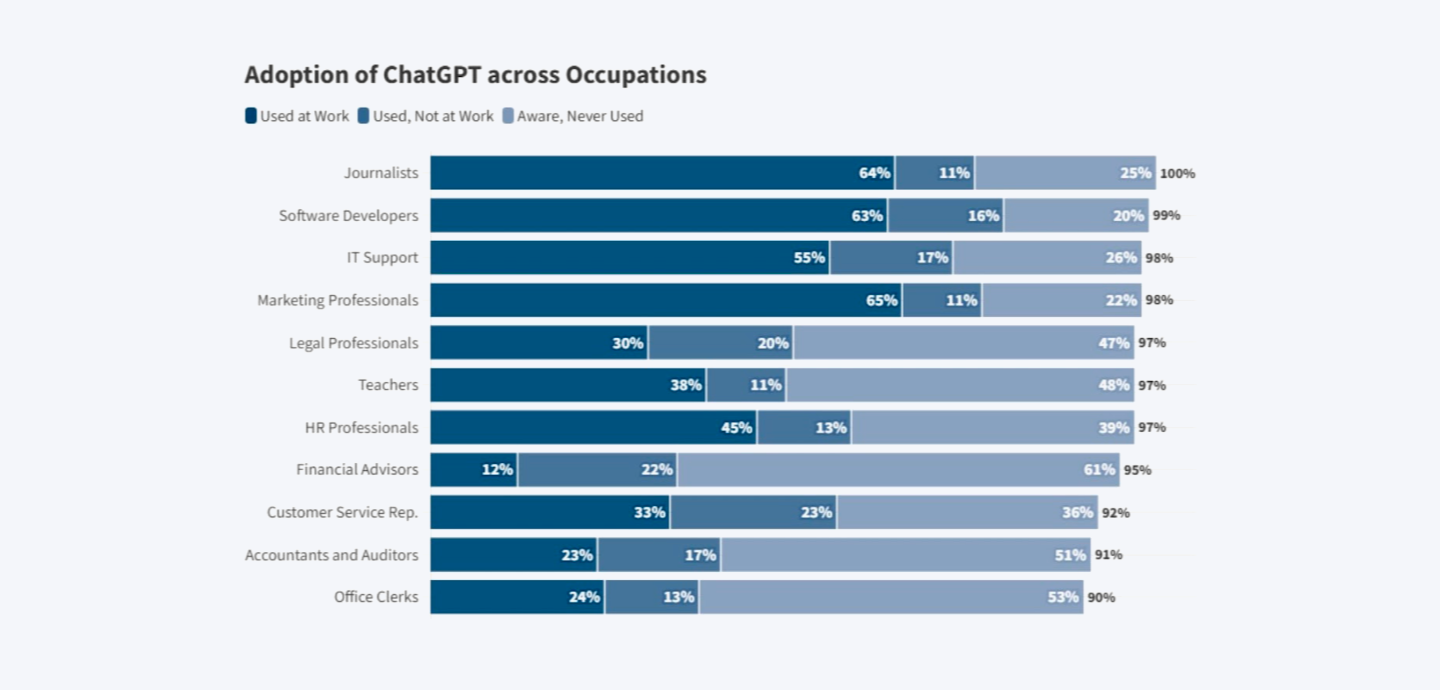
Financial professionals remain cautious about AI, possibly due to compliance concerns. But with 1 in 3 already using it, this industry may see more adoption soon.
How many U.S. employed adults use ChatGPT?
28% of employed U.S. adults use ChatGPT at work, up from 8% in 2023.
This 3.5x growth in work-related use over just two years shows how rapidly ChatGPT has entered the modern workplace.
ChatGPT demographics
Who uses ChatGPT more: men or women?
Women are 20% less likely to use ChatGPT than men in the same job.
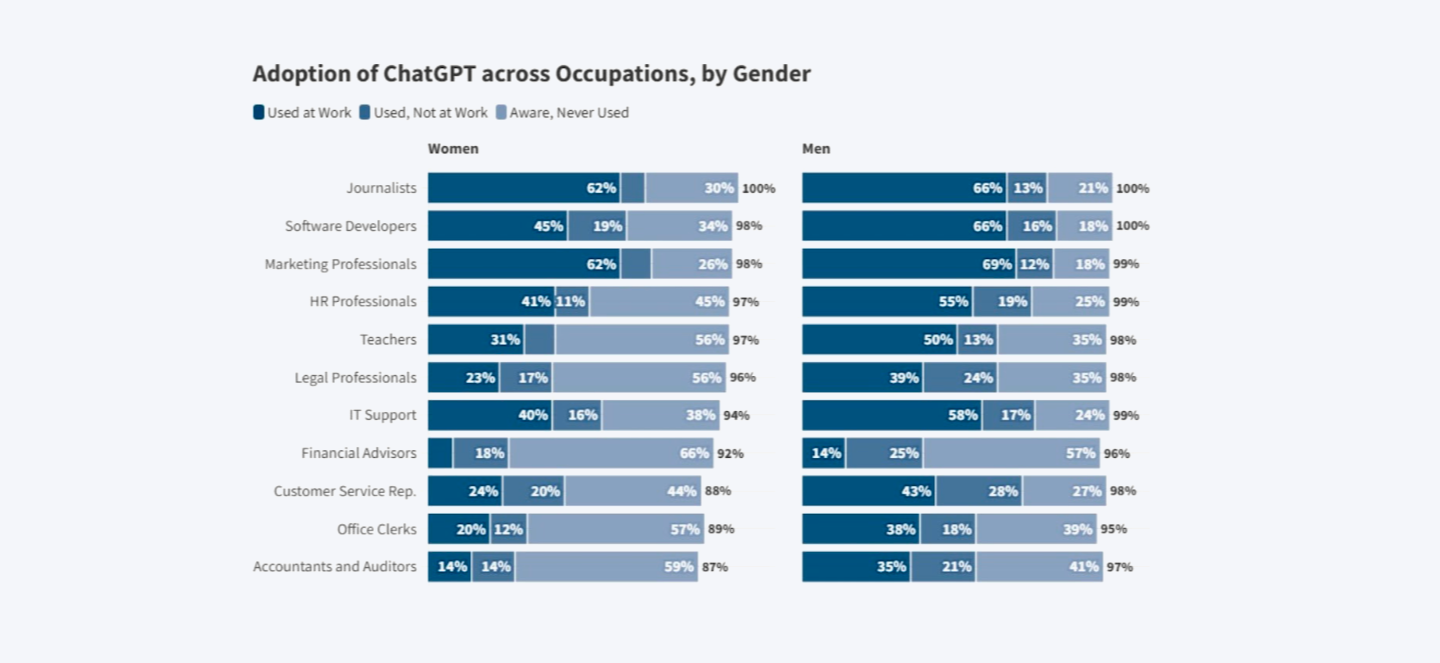
A clear gender gap exists in AI tool adoption. This may reflect broader issues in tech access, trust, or workplace dynamics.
What age group uses ChatGPT the most?
Among 18–24-year-olds, 56% have used ChatGPT at least once, and 16% of people above 55 years of age have used it..
Gen Z is the most AI-friendly generation so far. Their early and enthusiastic adoption may shape future job markets and education systems.
How is ChatGPT used in education?
About one-third of U.S. college-aged adults use ChatGPT, with roughly 25% of their messages related to school work.
ChatGPT is quickly becoming a digital study partner. Students rely on it for explanations, assignments, and writing help.
ChatGPT recognition and growth
How quickly did ChatGPT gain traction after its launch?
ChatGPT gained one million users just five days after its November 2022 launch.
This record-breaking growth showed immense public interest and demand for AI-powered assistance. It helped set a precedent for ChatGPT’s explosive user base.
What is the global recognition rate of ChatGPT?
ChatGPT is the most recognized and used generative AI tool across Argentina, Denmark, France, Japan, the UK, and the USA. It is 2-3x times more popular than Google Gemini and Microsoft Copilot.
ChatGPT’s dominance spans continents. It is not just a regional tool; it holds global mindshare, even in tech-savvy and AI-conscious markets.
How many people interact with ChatGPT daily?
Over 1 billion user messages are sent on ChatGPT every day.
This message volume reflects not just usage but reliance. It reveals ChatGPT’s integration into millions of daily workflows and personal routines.
ChatGPT Revenue and Business Performance
What’s the revenue forecast for OpenAI?
OpenAI reportedly generated $3.7 billion in revenue in 2024 and expects $29.4 billion by 2026. This massive projected jump shows growing monetization through consumer, enterprise, and API channels, reflecting ChatGPT’s shift from a novelty to a core business tool.
How much has OpenAI raised in funding?
OpenAI has raised $57.9 billion over 11 rounds, including a $40B Series F in March 2025 led by SoftBank.
OpenAI's capital-raising success positions it as a dominant player in AI innovation. Massive backing also signals investor belief in long-term profitability.
What portion of OpenAI’s B2C sales comes from ChatGPT Pro?
ChatGPT Pro makes up nearly 5.8% of OpenAI’s B2C sales. Though a small slice of the overall pie, Pro subscriptions represent loyal power users. These users drive consistent revenue and serve as use-case champions.
How dominant is ChatGPT in the paid AI tool space?
In November 2024, ChatGPT captured 62.5% of the market share of B2C AI subscription tools. No other paid AI tool even comes close. ChatGPT’s brand trust, functionality, and ease of use make it the clear market leader.
How much of OpenAI’s business is consumer-driven?
Roughly 75% of OpenAI’s business revenue comes from consumer subscriptions.
The company’s foundation rests on individuals using ChatGPT. This reinforces the need to keep improving usability and consumer features.
ChatGPT Language and Feature Access
How many languages does ChatGPT support?
ChatGPT presently supports 59 languages. Multilingual support allows ChatGPT to reach broader user bases and better serve global enterprises, educational institutions, and governments.
In how many countries is ChatGPT available?
ChatGPT is accessible in 188 countries and regions. ChatGPT is one of the most globally available tech platforms with a presence in nearly every country, ready for both personal and professional use.
ChatGPT in Enterprise Use Cases
Which Fortune 500 brands use ChatGPT?
Major brands like PwC, Canva, Zapier, Klarna, Carlyle, Estée Lauder, and Block are ChatGPT adopters. These early adopters validate the real-world business value of ChatGPT, from internal communication and customer support to software development.
What tools does ChatGPT Enterprise offer for admins?
ChatGPT Enterprise provides Single Sign-On (SSO), domain verification, a centralized admin console, and an analytics dashboard. These features make ChatGPT scalable for large organizations, helping IT teams manage usage, compliance, and productivity across departments.
It guarantees that customer data is never used to train models, ensuring full data segregation for enterprise clients. This assurance increases trust and paves the way for regulated industry adoption.
What’s the ROI for companies using ChatGPT Enterprise?
Klarna improved employee performance and scaled support to millions of users using ChatGPT. This shows how deploying ChatGPT Enterprise isn’t just about experimentation; it creates tangible productivity and support gains.
ChatGPT’s Market Share and Visibility
How much market share does ChatGPT have in AI chatbots?
ChatGPT owns 79.76% of the AI chatbot market as of June 2025. Its wide use, frequent updates, and brand strength make it difficult for competitors to catch up.
What is ChatGPT’s Authority Score online?
ChatGPT holds an authority score of 94. This high SEO score signifies credibility, widespread backlinks, and strong user engagement. It cements ChatGPT’s leadership in organic search visibility.
How many referring domains mention ChatGPT?
ChatGPT now has 158,640 referring domains, a 7.27% increase. More websites across industries are linking to ChatGPT, indicating growing brand reach, relevance, and content usage in thought leadership.
How does ChatGPT rank in organic vs. paid traffic?
ChatGPT saw 71.56M organic visits (+4.12%) and 18.01M paid visits (+23.56%) in June 2025. It means organic traffic still dominates the industry, but ChatGPT is increasingly investing in paid campaigns, possibly to target new sectors or geographies.
ChatGPT in the Workforce
How many workers say ChatGPT boosts their productivity?
Workers estimate that ChatGPT can cut the time spent on one-third of their job tasks by half. They say using ChatGPT is a time-saver. That perception alone justifies its place in day-to-day work for efficiency and output.
How many workers have been affected by GPTs?
Around 80% of U.S. workers could have at least 10% of their tasks affected, while 19% may see over half of their tasks impacted. Generative AI isn’t just an assistant; it’s reshaping how jobs are done. Entire workflows may be redesigned as GPTs gain more traction.
How does education level affect ChatGPT usage?
45% of postgraduates use ChatGPT for work vs. 36% (bachelor’s), 25% (some college), and 17% (high school or less).
Higher-educated professionals are early adopters of ChatGPT, likely due to comfort with new tools and the nature of their work, benefiting from AI augmentation.
Developer Engagement and Mobile Reach
How many developers in the U.S. have built on OpenAI?
1.3 million U.S. developers have created projects on OpenAI’s platform. This developer base contributes to rapid experimentation and the rise of AI-enhanced apps, services, and plugins.
How many total weekly active users does ChatGPT have now?
ChatGPT currently has 300 million weekly active users. Compared to earlier numbers, this represents a rise, suggesting ChatGPT’s stickiness and growing user demand on a weekly cycle.
How many iOS and Android devices have ChatGPT installed?
ChatGPT reached 52 million iOS and Android installs, up 12% since March and 38% since January.
Strong month-over-month ChatGPT installation growth indicates surging mobile usage and brand penetration into mainstream mobile habits.
ChatGPT and AI-Generated Content
Can users identify if content was AI-generated?
In a survey of 1,900 Americans, 53% couldn’t identify AI-written content, rising to 63.5% with GPT-4.
AI content has become incredibly realistic. GPT-4’s output is often indistinguishable from human writing, raising new challenges for content detection and attribution.
How much better is GPT-4 than GPT-3.5 at sounding human?
GPT-4 is 16.5% more convincing than GPT-3.5 in making users believe the content was human-written. The jump in believability demonstrates rapid improvements in language quality, tone, and coherence from one generation to the next.
What are the top use cases for ChatGPT?
ChatGPT is mainly used for media creation (28%) and information search (24%).
Users generate content like emails, stories, essays, and ask factual questions on ChatGPT. This confirms the platform’s creative edge over being just a search alternative.
According to Statista, 20% of the adults use ChatGPT for work, 17% to learn something new, and 17% for entertainment.
How is media creation divided?
Media creation by ChatGPT includes writing text (Email (9%), essays (8%), creative writing (7%)), image generation (9%), coding (5%), video generation (4%), audio generation (3%), and casual experimentation (11%).
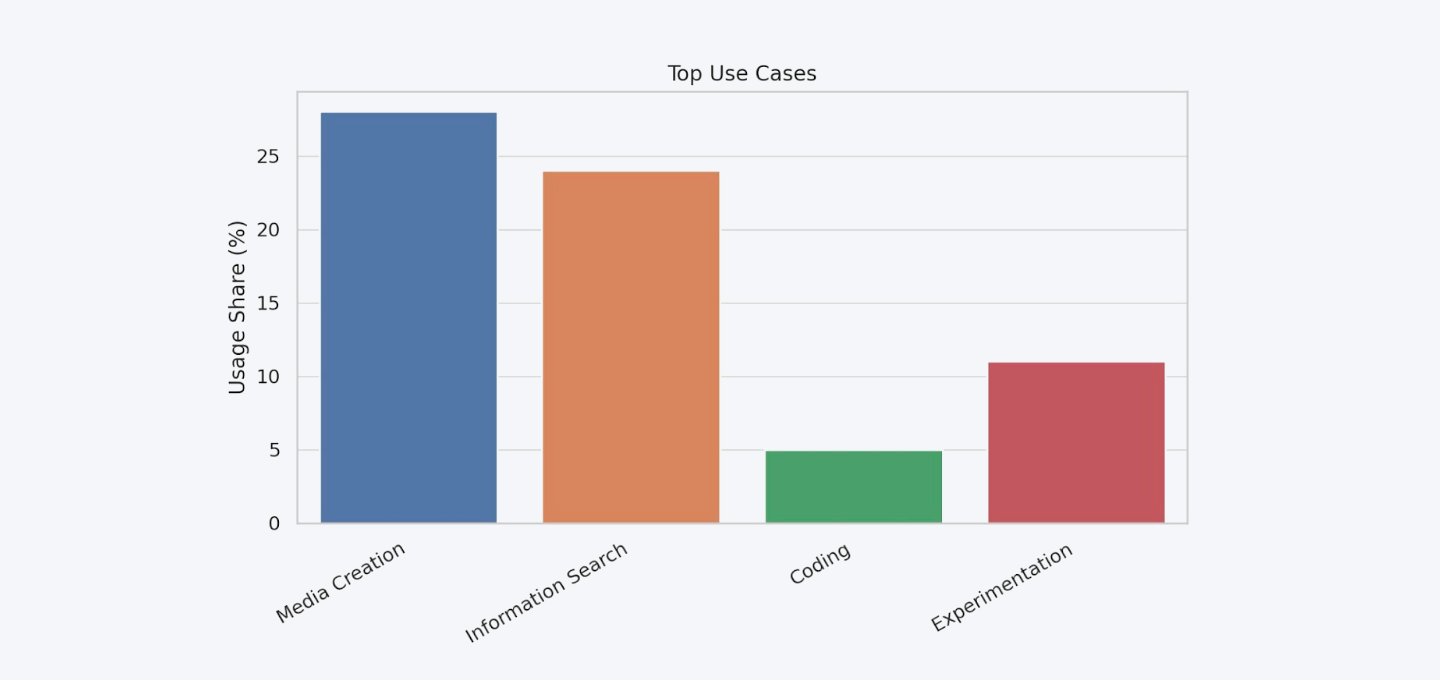
ChatGPT serves many creator personas. Whether you’re writing, coding, or just playing with ideas, it meets a wide variety of creative demands.
How many people worldwide use ChatGPT systems?
Sam Altman said around 10% of the world now uses ChatGPT systems, nearly 800 million people.
This estimate showcases ChatGPT’s reach beyond active app users. It hints at broader adoption through integrations, API usage, and third-party apps.
ChatGPT vs Perplexity: Which AI Assistant Is Better for Coding?
FAQs
How many people use ChatGPT each day or week in 2025?
As of mid-2025, ChatGPT sees over 1 billion daily messages and 300 million weekly active users. This shows that people are not just trying ChatGPT, but using it regularly across tasks like writing, coding, and learning.
How loyal are ChatGPT's paying users?
89% of paid users stay subscribed for at least one quarter, and 74% continue for three quarters, based on Earnest credit card data. This high retention proves user satisfaction and ChatGPT’s ongoing value.
What’s ChatGPT’s market share among paid AI tools?
ChatGPT holds a 62.5% share of the B2C AI subscription market and 79.76% of the chatbot market, making it the undisputed leader in paid generative AI tools globally.
4. How is ChatGPT used across professions in the workplace?
28% of employed U.S. adults use ChatGPT at work. 79% of developers use it for daily coding tasks, while 34% of financial advisors use it for insights and summaries, showing varied yet growing professional use.
5. How fast is ChatGPT growing in mobile usage?
ChatGPT has crossed 500 million downloads on Google Play, with 52 million installs across Android and iOS in early 2025 alone. Mobile adoption has grown 38% since January 2025, highlighting its increasing presence on smartphones worldwide.
Data sources
- statista.com
- semrush.com
- bfi.uchicago.edu
- bloomberg.com
- openai.com
- businessofapps.com
- forbes.com
- reutersinstitute.politics.ox.ac.uk
- earnestanalytics.com
- pymnts.com
- tracxn.com
- help.openai.com
- nerdynav.com
- gs.statcounter.com
- pewresearch.org
- play.google.com
- appfigures.com
- tooltester.com
















0 Comments